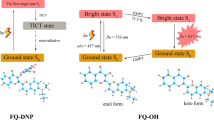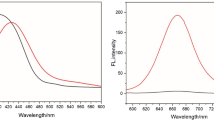Abstract
The development of fluorescent probe for hydrazine (N2H4) detection has attracted much attention due to the important role of N2H4 plays in the fields of medicine, agriculture, biology and environments. In this paper, the optical properties and water solubility of two novel two-photon fluorescent molecular probes (Probe1 and Probe2) before and after the reaction with N2H4 are studied by using the density function theory. The results show that electronic distribution and transition dipole moment of the probes are obviously changed after the reaction with N2H4, thus the optical properties of the molecules are influenced and the detection of N2H4 are realized. In addition, photoinduced electron transfer processes for Probe1 and Probe2 in the presence of N2H4 are theoretically characterized, which explains the experimental observations from the microscopic mechanism. Special attention has been paid on the analysis of the two-photon absorption for the probes with the absence and presence of N2H4 by the response theory method. Both probes with good water solubility show large variation on the two-photon absorption cross section when reacts with N2H4. In particular, the two-photon absorption response of Probe2 is more obvious, so it possesses preferable two-photon fluorescence microscopic imaging ability. More importantly, the receptor effect on the sensing performances of the probes are demonstrated, providing a theoretical reference for the design and synthesis on more efficient two-photon fluorescence N2H4 probes. Our study provides necessary information on the response mechanism of the studied chemosensors and helps to establish the relationship between the structure and optical properties of two-photon fluorescence N2H4 probes.









Similar content being viewed by others
Data Availability
The data and materials are available within the manuscript.
References
He L, Huang Y, Wang A, Wang X, Chen X, Delgado JJ, Zhang T (2012) A noble-metal-free catalyst derived from Ni-Al hydrotalcite for hydrogen generation from N2H4⋅H2O decomposition. Angew Chem Int Edit 51:6191–6194
Tang T, Chen YQ, Fu BS, He ZY, Xiao H, Wu F, Wang JQ, Wang SR, Zhou X (2016) A novel resorufin based fluorescent “turn-on” probe for the selective detection of hydrazine and application in living cells. Chin Chem Lett 27:540–544
Shi X, Huo F, Chao J, Yin C (2018) A ratiometric fluorescent probe for hydrazine based on novel cyclization mechanism and its application in living cells. Sensor Actuat B-Chemical 260:609–616
Sanabria-Chinchilla J, Asazawa K, Sakamoto T, Yamada K, Strasser P (2011) Noble metal-free hydrazine fuel cell catalysts: Epoc effect in competing chemical and electrochemical reaction pathways. J Am Chem Soc 133:5425–5431
Wu G, Tang X, Ji W, Lai K, Tong Q (2017) A turn-on fluorescent probe based on coumarin-anhydride for highly sensitive detection of hydrazine in the aqueous solution and gas states. Methods Appl Fluores 5:015001
Reilly CA, Aust SD (1997) Peroxidase substrates stimulate the oxidation of hydralazine to metabolites which cause single-strand breaks in DNA. Chem Res Toxicol 10:328–334
Chen S, Hou P, Wang J, Liu L, Zhang Q (2017) A highly selective fluorescent probe based on coumarin for the imaging of N2H4 in living cells. Spectrochim Acta A 173:170–174
Xiao L, Tu J, Sun S, Pei Z, Pei Y, Pang Y, Xu Y (2014) A fluorescent probe for hydrazine and its in vivo applications. RSC Adv 4:41807–41811
Xu W, Liu W, Zhou T, Yang Y, Li W (2018) A novel PBT-based fluorescent probe for hydrazine detection and its application in living cells. J Photoch Photobiolo A 356:610–616
Liu Y, Ren D, Zhang J, Li H, Yang X-F (2019) A fluorescent probe for hydrazine based on a newly developed 1-indanone-fused coumarin scaffold. Dyes Pigment 162:112–119
Zhou L, Li Y, Zhou A, Zhang G, Cheng ZQ, Ge YX, Liu SK, Azevedo RB, Zhang J, Jiang S, Jiang CS (2020) A new endoplasmic reticulum (Er)-targeting fluorescent probe for the imaging of cysteine in living cells. J Fluoresc 30:1357–1364
Zhang J, Ning L, Liu J, Wang J, Yu B, Liu X, Yao X, Zhang Z, Zhang H (2015) Naked-eye and near-infrared fluorescence probe for hydrazine and its applications in in vitro and in vivo bioimaging. Anal Chem 87:9101–9107
Hu C, Sun W, Cao J, Gao P, Wang J, Fan J, Song F, Sun S, Peng X (2013) A ratiometric near-infrared fluorescent probe for hydrazine and its in vivo applications. Org Lett 15:4022–4025
Ou-Yang J, Jiang WL, Tan KY, Liu HW, Li SJ, Liu J, Li YF, Li CY (2018) Two-photon fluorescence probe for precisely detecting endogenous H2S in lysosome by employing a dual lock system. Sensor Actuat B-Chemical 260:264–273
Liu Y, Liu W, Li H, Yan W, Yang X, Liu D, Wang S, Zhang J (2018) Two-photon fluorescent probe for detection of nitroreductase and hypoxia-specific microenvironment of cancer stem cell. Anal Chim Acta 1024:177–186
Yu SL, Wang SX, Yu HZ, Feng Y, Zhang ST, Zhu MY, Yin H, Meng XM (2015) A ratiometric two-photon fluorescent probe for hydrazine and its applications. Sensors Actuat B-Chem 220:1338–1345
Wang JY, Liu ZR, Ren M, Lin W (2017) 2-benzothiazoleacetonitrile based two-photon fluorescent probe for hydrazine and its bio-imaging and environmental applications. Sci Rep 7:1530
Yan S, Guo H, Tan J, Jiang J, Xiao H (2020) Two novel spirobifluorene-based two-photon fluorescent probes for the detection of hydrazine in solution and living cells. Talanta 218:121210
Leng J, Xin J, Zhou H, Li K, Hu W, Zhang Y (2021) Theoretical insights into sensing performances of rhodamine-contained two-photon fluorescent probes for mercury ion. Inter J Quantum Chem 121:e26435
Liu XT, Zou LY, Ren AM, Guo JF, Sun Y, Huang S, Feng JK (2011) Theoretical investigation of one- and two-photon spectra of pyrazabole chromophores. Theor Chem Acc 130:37
Frisch M J, Trucks G W, Schlegel H B, Scuseria G E, Robb M A, Cheeseman J R, Scalmani G, Barone V, Petersson G A, Nakatsuji H, Li X, Caricato M, Marenich A V, Bloino J, Janesko B G, Gomperts R, Mennucci B, Hratchian H P, Ortiz J V, Izmaylov A F, Sonnenberg J L, Williams, Ding F, Lipparini F, Egidi F, Goings J, Peng B, Petrone A, Henderson T, Ranasinghe D, Zakrzewski V G, Gao J, Rega N, Zheng G, Liang W, Hada M, Ehara M, Toyota K, Fukuda R, Hasegawa J, Ishida M, Nakajima T, Honda Y, Kitao O, Nakai H, Vreven T, Throssell K, Montgomery Jr. J A, Peralta J E, Ogliaro F, Bearpark M J, Heyd J J, Brothers E N, Kudin K N, Staroverov V N, Keith T A, Kobayashi R, Normand J, Raghavachari K, Rendell A P, Burant J C, Iyengar S S, Tomasi J, Cossi M, Millam J M, Klene M, Adamo C, Cammi R, Ochterski J W, Martin R L, Morokuma K, Farkas O, Foresman JB, Fox DJ (2016). Gaussian 16 rev. C.01. (Wallingford, CT)
Dalton (2013) References in https://daltonprogram.org/. Accessed 7 Jul 2021
Cancès E, Mennucci B, Tomasi J (1997) A new integral equation formalism for the polarizable continuum model: Theoretical background and applications to isotropic and anisotropic dielectrics. J Chem Phys 107:3032–3041
Cossi M, Barone V, Mennucci B, Tomasi J (1998) Ab initio study of ionic solutions by a polarizable continuum dielectric model. Chem Phys Lett 286:253–260
Chi WJ, Sun PP, Li ZS (2016) A strategy to improve the efficiency of hole transporting materials: Introduction of a highly symmetrical core. Nanoscale 8:17752–17756
Marenich AV, Cramer CJ, Truhlar DG (2009) Universal solvation model based on solute electron density and on a continuum model of the solvent defined by the bulk dielectric constant and atomic surface tensions. J Phys Chem B 113:6378–6396
Guo XH, Yu LB, Hao XL, He TF, Guo JF, Wei X, Cui WB, Yu LY, Qu ZX, Ren AM (2021) Theoretical study of a two-photon fluorescent probe based on nile red derivatives with controllable fluorescence wavelength and water solubility. J Chem Inf Model 61:5082–5097
Kelly CP, Cramer CJ, Truhlar DG (2005) Sm6: A density functional theory continuum solvation model for calculating aqueous solvation free energies of neutrals, ions, and solute−water clusters. J Chem Theory Comput 1:1133–1152
Funding
This work was supported by the Natural Science Foundation of Shandong Province of China (No. ZR2020MA081) and Research Leader Program of Jinan Science and Technology Bureau ( No. 2019GXRC061).
Author information
Authors and Affiliations
Contributions
Methodology: Jiancai Leng and Yujin Zhang; Investigation: Tengfei Jiang and Ni Luan; Writing—original draft preparation: Tengfei Jiang, Ni Luan and Longping Wang; Writing—review and editing: Jiancai Leng and Yujin Zhang; Supervision: Jiancai Leng and Yujin Zhang.
Corresponding authors
Ethics declarations
Ethics Approval
Not applicable.
Consent to Participate
Not applicable.
Consent to Publish
Not applicable.
Conflicts of Interest
No relevant financial or non-financial interests to disclose. The authors declare no competing interests.
Additional information
Publisher's Note
Springer Nature remains neutral with regard to jurisdictional claims in published maps and institutional affiliations.
Rights and permissions
Springer Nature or its licensor (e.g. a society or other partner) holds exclusive rights to this article under a publishing agreement with the author(s) or other rightsholder(s); author self-archiving of the accepted manuscript version of this article is solely governed by the terms of such publishing agreement and applicable law.
About this article
Cite this article
Jiang, T., Luan, N., Wang, L. et al. Theoretical Insights on the Sensing Performance for Newly-synthesized Two-photon Fluorescent N2H4 Probes Based on Spirobifluorence. J Fluoresc 33, 1949–1959 (2023). https://doi.org/10.1007/s10895-023-03209-z
Received:
Accepted:
Published:
Issue Date:
DOI: https://doi.org/10.1007/s10895-023-03209-z




